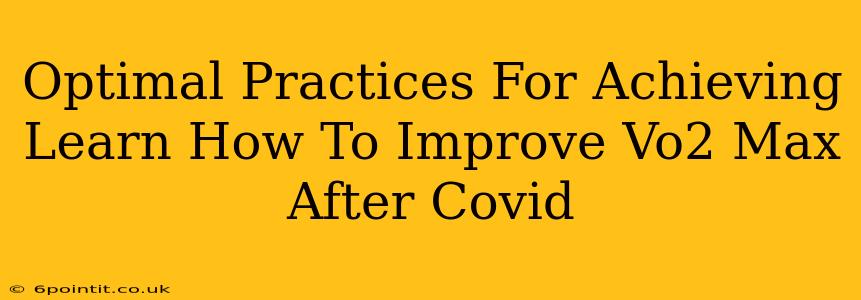COVID-19 can significantly impact your cardiovascular health, often resulting in reduced VO2 max – a crucial measure of your body's ability to utilize oxygen during exercise. Recovering your fitness levels and improving your VO2 max after COVID requires a careful and considered approach. This guide outlines optimal practices to help you safely and effectively rebuild your cardiovascular fitness.
Understanding VO2 Max and its Impact After COVID-19
VO2 max, or maximal oxygen consumption, represents the maximum amount of oxygen your body can utilize during intense exercise. A lower VO2 max after COVID-19 is common due to various factors including:
- Lung damage: COVID-19 can cause inflammation and scarring in the lungs, reducing their efficiency in oxygen uptake.
- Cardiovascular complications: The virus can affect the heart muscle, leading to decreased cardiac output and reduced oxygen delivery.
- Muscle weakness and deconditioning: Prolonged illness and inactivity can lead to significant muscle loss and reduced endurance.
- General fatigue and reduced energy levels: Post-COVID fatigue can significantly impact your ability to engage in strenuous activity.
A Phased Approach to Improving VO2 Max Post-COVID
Rebuilding your fitness after COVID-19 should be a gradual process. Avoid pushing yourself too hard too soon, as this could lead to setbacks and potential complications. A phased approach is crucial:
Phase 1: Assessment and Gradual Reintroduction to Exercise
Consult your doctor: Before starting any exercise program, it's essential to consult your doctor or a healthcare professional. They can assess your current health status and advise on safe exercise guidelines based on your individual needs and recovery progress.
Start slowly: Begin with low-intensity activities like short walks or gentle cycling for a few minutes each day. Listen to your body and rest when needed. Focus on consistency rather than intensity.
Monitor your symptoms: Pay attention to any signs of exertion like shortness of breath, chest pain, or extreme fatigue. If you experience any of these symptoms, stop exercising and consult your doctor.
Phase 2: Increasing Intensity and Duration
As your fitness improves, you can gradually increase the intensity and duration of your workouts. This might involve:
- Increasing walking or cycling time: Gradually extend your workouts by a few minutes each week.
- Incorporating interval training: Alternate between periods of high-intensity exercise and periods of rest or low-intensity exercise. This can be highly effective in improving VO2 max.
- Adding strength training: Building muscle mass can improve your overall fitness and enhance your body's ability to utilize oxygen.
Prioritize consistency: Regular exercise, even at a moderate intensity, is more effective than sporadic high-intensity sessions.
Phase 3: Advanced Training and Monitoring Progress
Once you've built a solid base of fitness, you can start incorporating more advanced training techniques like:
- High-intensity interval training (HIIT): This involves short bursts of intense exercise followed by periods of recovery.
- Tempo runs: Running at a comfortably hard pace for a sustained period.
- Fartlek training: A type of variable-intensity running that involves alternating between fast and slow speeds.
Track your progress: Monitor your heart rate, perceived exertion, and any other relevant metrics to track your progress and adjust your training program accordingly. Consider using a fitness tracker or consulting with a certified personal trainer.
Lifestyle Factors Supporting VO2 Max Improvement
Beyond exercise, lifestyle factors play a crucial role in optimizing your VO2 max recovery:
- Nutrition: Maintain a healthy, balanced diet rich in fruits, vegetables, and lean protein.
- Hydration: Drink plenty of water throughout the day, especially before, during, and after exercise.
- Sleep: Aim for 7-9 hours of quality sleep per night to allow your body to recover and repair.
- Stress management: Chronic stress can negatively impact your cardiovascular health. Practice relaxation techniques like yoga or meditation.
Patience and Persistence are Key
Improving your VO2 max after COVID-19 takes time and patience. Don't get discouraged if you don't see immediate results. Focus on making consistent progress, listening to your body, and celebrating your achievements along the way. With dedication and a thoughtful approach, you can regain your fitness and improve your VO2 max post-COVID. Remember to always consult with your healthcare provider before starting any new exercise program.

